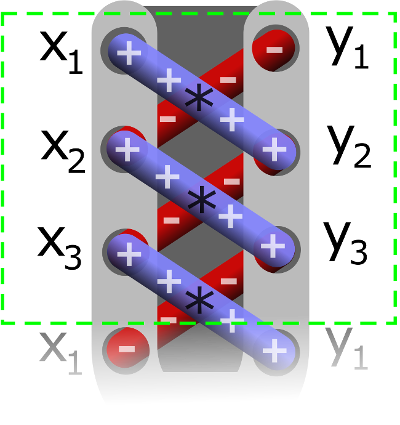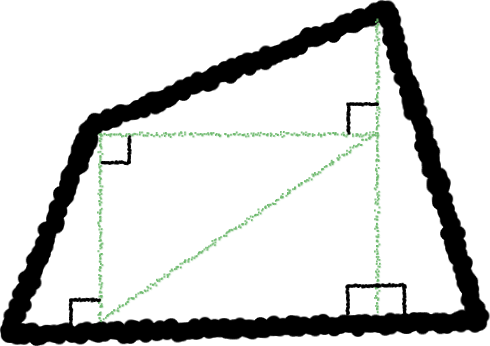Blog
Gauss’ shoelace formula
There’s a useful trick I learned the other day while working some geospatial data. I needed to compute the areas of millions of polygons very quickly - which initially looked like a fairly daunting task. It turns out that there’s a very fast and efficient method developed by Gauss that was designed for computing the area of any simple polygon (a simple polygon is a closed-path flat shape consisting of non-intersecting line segments - i.e. no curves and no overlaps).
It’s called the shoelace formula (for reasons that will become clear later), and it’s quite elegant. Given a list of the vertices, the shoelace algorithm breaks a polygon down into triangles and computes each of their areas instead. Once these areas are known, they can all just be added together - which gives you the area of the original polygon. What I find interesting is just how simple the algorithm is.
Triangles have some handy properties; firstly, their areas can be computed cheaply with a very simple closed-form solution - and secondly, any polygon can be broken down into a number of triangles. This makes sense - mathematicians like to solve difficult problems by breaking them down into smaller, easier problems - and solving those instead.
Here’s how it works. For the sake of simplicity, let’s start with a common-or-garden right-angled triangle.

The area of this triangle is easily computed; $A = \frac{1}{2bh}$. Gauss' shoelace formula looks a little more complicated…
$$ A = \frac{1}{2} | \sum_{i=1}^{n-1} x_{i}y_{i+1} + x_{n}y_{1} - \sum_{i=1}^{n-1} x_{i+1}y_{i} - x_{1}y_{n} | $$
where $(x_{i}, y_{i})$ are the coordinates of each vertex (thus $\mathbf{x}$ and $\mathbf{y}$ are vectors containing the polygon’s vertices). It isn’t as intimidating as it looks, and the algorithm is probably better explained using an image (which I purloined sneakily from Wikipedia).

Essentially, you cross-multiply each $x_{i}$ coordinate with each $y_{i-1}$ coordinate, and then divide the result by 2. As you work down through the vector of vertices, this will have the effect of computing the area of each individual triangle that comprises the polygon. Using our right-angled triangle from above, here are three imaginary points - one corresponding to each vertex.
| Vertex | $\mathbf{x}$ | $\mathbf{y}$ |
|---|---|---|
| a | 3 | 5 |
| b | 3 | 2 |
| c | 8 | 2 |
Using Gauss’ formula, area of this triangle is computed like so;
- $(3 \times 2) - (5 \times 3) = -9$
- $(3 \times 2) - (2 \times 8) = -10$
- $(8 \times 5) - (2 \times 3) = 34$ (note here that we’re “wrapping around” the top of the vector)
Adding all of these areas together gives and dividing by two results in an area of $7.5$. We can verify this quite easily: $\frac{1}{2} (5 \times 3) = 7.5$. This is a bit over-complicated for a triangle - but this method works just as well on polygons with an arbitrary number of vertices.
You may have noticed that one of the areas above is negative. The reason is that the quantity $(x_{n-1}y_{n}) - (x_{n}y_{n-1})$ simply describes the rectangle that has one particular vertex at its top right, and another at its bottom left. For the right-angled triangle shown above, the area given by $(x_{n-1}y_{n}) - (x_{n}y_{n-1})$ defines the rectangle with vertex $b$ at its lower left, and vertex $d$ at its upper right. Dividing this area by two gives the area of triangle $abc$.
So what about a more complex polygon? The same procedure applies, but the shape gets broken up into right-angled triangles first.

So there we have it - Gauss’ shoelace algorithm. It’s so compact and elegant for such a neat piece of geometric reasoning. When implementing this in a programming language that supports vectorisation, it boils down to just four lines of code…
# See https://stackoverflow.com/a/49129646/2321244
def shoelace(xs, ys):
main_area = np.dot(xs[:-1], ys[1:]) - np.dot(ys[:-1], xs[1:])
correction = (xs[-1] * ys[0]) - (ys[-1] * xs[0])
return np.abs(main_area + correction) / 2
…and runs in mere microseconds. Fantastic really, considering that Gauss died over 150 years ago.